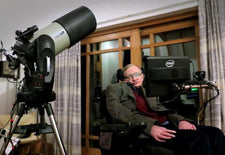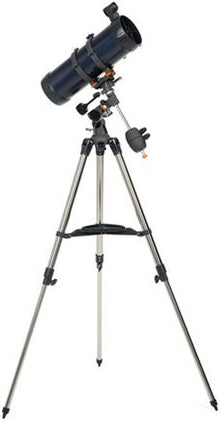Telescope Glossary
May 4, 2015
Amateur astronomers love to use jargon. With this list of basic telescope and astronomy terms under your belt, you can keep up with any conversation!
Absolute magnitude: A measurement of a star's intrinsic or true brightness, as measured from a standard distance of 10 parsecs. Compared with apparent magnitude, absolute magnitude provides a more accurate measure of the object’s brightness, without regard for its proximity to the Earth.
Accessory tray: An attached shelf on the telescope's mount or tripod for diagonals, eyepieces, lenses, etc. The tray also can be a center brace for a tripod.
Achromat: Also known as an achromatic objective lens, a refractor objective lens that contains elements of two types of glass, helping to reduce chromatic aberration.
Altazimuth mount: A two-axis mount for supporting and pointing a telescope freely in altitude (up and down) and azimuth (side to side), as in a standard photographic tripod.
Altitude and azimuth: The two directions used to describe the position of an object in the sky as viewed from a particular location at a particular time. Altitude measures the vertical position, while azimuth measures the horizontal.
Aperture: The opening that determines the cone angle of a bundle of rays that come to a focus in the image plane. In optics, the aperture refers to the size of the objective lens. As the aperture increases, so does image brightness and resolution.
Apochromatic: A photographic or refractor lens that uses exotic glasses or two or more lens elements to eliminate chromatic aberration.
Apparent magnitude: A measure of the brightness of a star to the naked eye. The brighter the star appears, the lower the magnitude value.
Arc minute: A unit of angular distance equal to a 1/60th of a degree. A one-degree angle has 60 arc minutes.
Arc second: A unit of angular measurement equal to a 1/60th of an arc minute. A one-degree angle has 3,600 arc seconds.
Astigmatism: Most often encountered with inferior ground optics, an aberration that prevents light from coming to focus on one plane.
Baffles: Rings within a refractor's tube with apertures that prevent internal light scatter and increase contrast.
BaK-4 glass: A superior-quality glass used to make optical prisms that produce bright images and extreme contrast.
Balance system: The use of weights to counterbalance a telescope's optical tube assembly.
Barlow lens: Named for English engineer Peter Barlow, a diverging lens that, when used with other optics, effectively increases the focal ratio of an optical system—up to double or triple.
Binocular: Two small side-by-side telescopes (sometimes with a central focusing system) used for viewing with both eyes.
Binocular tripod adapter: A device used to mount a binocular to the pan head of a tripod.
BK-7 glass: An extremely common optical glass used in precision lenses.
Blower bulb: A hand-squeezed device that produces brief gusts of air to safely clean optical surfaces.
Camera adapter: A tele-extender or T-adapter that attaches to the telescope focuser's drawtube and is connected by means of an optional T-ring.
Cassegrain: A combination of a primary concave mirror and a secondary convex mirror used in optical telescopes.
Catadioptric: An optical system that combines lenses and curved mirrors to form an image.
CCD camera: In astrophotography, a camera with a CCD sensor dedicated capturing images of deep sky or Solar System objects.
Center-mark: Found on the primary mirror of a Newtonian reflector, a small centered mark that aids in collimating the optics.
Coated optics: An optical system with a magnesium fluoride coating applied to at least one optical surface for enhanced contrast and light transmission.
Collimation: The optical alignment of a reflector or catadioptric’s primary and secondary mirrors.
Computerized telescope: A telescope that automatically locates celestial objects and tracks them as they appear to drift across the night sky.
Counterweight: A weight placed on a telescope mount to counterbalance the optical tube assembly.
Crown glass: A type of glass produced from alkali-lime silicates containing approximately 10 percent potassium oxide.
Declination: One of two coordinates of a point on the celestial sphere in the equatorial coordinate system. The other coordinate is called right ascension (R.A.).
Degree: The measurement equal to 1/360th of a circle. One degree approximately equals the diameter of two full moons side by side in the sky.
Dew shield: A metal or flexible plastic tube about the same diameter as the optical tube of a telescope that prevents dew from forming on the objective lens or corrector.
Dew zapper: Placed around the telescope tube, a flexible heating strap that keeps the corrector's temperature above the ambient air's dew point.
Diffraction limited: An optical system with the ability to produce images with angular resolution that is as good as the instrument's theoretical limit.
Dispersion: The refraction at a slightly different angle of each wavelength of light when passing through a material at an angle. This causes chromatic aberration in lenses.
Dobsonian: An altazimuth mounted telescope on a rocker box base, developed by and named for amateur astronomer John Dobson.
Double star/binary star: A star system consisting of two stars orbiting around their common center of mass.
Dovetail bracket: A device used to secure finderscopes with a dovetail base onto the optical tube.
ED (extra-low dispersion) glass: A special type of glass with refractive properties that are superior to standard optical glass.
Emission nebula: A cloud of ionized gas emitting light of various colors. The Orion and Lagoon nebulae are examples.
Equatorial mount: Also known as German equatorial mount, a telescope mount developed for easy tracking of celestial objects relative to the celestial pole.
Erecting prism: A right-angled optical prism used to turn an inverted image upright.
Exit pupil: Also known as the Ramsden disk, a virtual aperture in a telescope's eyepiece.
Eye guard: A rubber eyepiece cup that shields light from the side of the telescope.
Eyepiece: An important part of the telescope, it magnifies the image. Eyepieces usually consist of three or more optical elements.
Field of view, apparent: The angular diameter, expressed in degrees, of the light seen by the human eye.
Field of view, true: The actual angle of sky seen through the eyepiece when attached to the telescope.
Finderscope: A small telescope that mounts to the main telescope used for sighting objects in the sky.
Focuser: Inserted into the eyepiece, it adjusts to bring objects into focus.
Galaxy: Hundreds of billions of stars that are close together. Examples include the Milky Way and the Andromeda Galaxy.
German equatorial mount: See equatorial mount.
Globular cluster: A highly concentrated mass of several thousands to millions of stars believed to be remnants of galaxy formation.
Guidescope: An inexpensive refractor that affixes to another telescope on the same mounting for astrophotography.
Illuminated reticle eyepiece: a red-illuminated guiding (or crosshair reticle) eyepiece used during astrophotography. It can be adjusted for brightness.
Interpupillary distance: The space between the centers of the two pupils of the observer's eyes. Binoculars can be adjusted for each individual's interpupillary distance.
Lens element: an optical lens or assembly of lenses used to make images of objects on either photographic film or on other media capable of storing images electronically.
Light pollution: Excessive or intrusive artificial light that hinders visibility of stars.
Magnesium fluoride: White crystalline salt composed of one magnesium ion and two fluoride ions used as coating applied to optical surfaces of refractors and eyepieces.
Magnification: The ratio between the apparent size of an object (its size in an image) and its true size. For example, a telescope with a 1200mm focal length and an eyepiece of 40mm has a 30x magnification.
Magnitude: A measure of the brightness of a celestial object. The lower the magnitude number, the brighter the object. See absolute magnitude and apparent magnitude.
Maksutov-Cassegrain (Mak, Mak-Cass): A catadioptric telescope that uses a full diameter meniscus lens (also called a corrector plate) to reduce off-axis aberrations such as coma found in reflecting telescopes while avoiding chromatic aberration.
Meniscus lens: A Maksutov telescope lens with two spherically curved faces—one convex, the other concave—giving it the form of a shell.
Messier objects: A set of astronomical objects first cataloged in the late 18th Century by French astronomer Charles Messier.
Mirror cell: A frame designed to hold the primary mirror of a reflecting telescope.
Monocular: A low-power, miniature telescope or spotting scope that is held in your hand like a binocular but used with one eye like a telescope.
Motor drive: A motorized drive system that makes it easier to find and track objects in the night sky. There are two basic types of motor drives, single-axis and dual-axis.
Multi-coated optics: An optical system coated with a layer of magnesium fluoride and some multiple anti-reflection coatings on some surfaces. It's a step up from fully coated but short of being fully multi-coated.
Near focus: Also called close focus, the distance between the spotting scope or binocular and the nearest object it can bring into sharp focus.
Nebula: An interstellar cloud of dust, hydrogen gas, and plasma.
Newtonian reflector: A type of reflecting telescope invited by British scientist Sir Isaac Newton that uses a concave primary mirror and a flat diagonal secondary mirror.
NGC catalog: A well-known catalog of 7,840 deep sky objects.
Objective lens: The lens or mirror in a telescope or binocular that gathers the light coming from the observed object and focuses the rays to produce the real image.
Off-axis guider: In astrophotography, a device that uses a prism to capture a small outlying area of a telescope's field of view, allowing a view through a guiding eyepiece or autoguider.
Open star cluster: A group of as many as a few thousand stars formed from the same giant molecular cloud and still loosely gravitationally bound to each other.
Optical tube assembly (OTA): A telescope's main tube, complete with primary mirror or objective lens, focuser, and finderscope. A mount or tripod is not included.
Parabolic mirror: A parabola-shaped reflective device used to collect or distribute light, sound, or radio waves.
Parfocal: A lens that stays focused when magnification/focal length is changed. Parfocal eyepieces can be swapped out without refocusing the telescope.
Planetary nebula: A celestial object formed when a star can no longer support itself by fusion reactions in its center. Examples include the Ring and the Dumbbell nebulae.
Planisphere: A star chart with two adjustable disks rotating on a common pivot. It can be adjusted to display the visible stars for any time and date.
Polar alignment: The act of aligning the rotational axis of a telescope's equatorial mount so that it is parallel the Earth's axis.
Polar alignment scope: Also called a polar axis finder, a small finderscope built into or placed into the right ascension axis of an equatorial mount for easier polar alignment.
Power: The magnification of a telescope. For example, 40x is known as 40 power.
Primary mirror: The principal light-gathering surface, or objective, of a reflecting telescope.
Prism: A solid piece of optical glass cut with flat surfaces used in star diagonals and binoculars. Most prisms are made from either BK-7 or BaK-4 glass.
Prism, porro: Named for its inventor, Ignazio Porro, a reflective prism used in an optical path to alter the orientation of an image.
Prism, roof: Any kind of reflective optical prism containing a section where two faces meet at a 90 degree angle. Also called a Dach prism.
Pyrex: High-quality glassware originally made from thermal shock-resistant borosilicate glass, an ideal material for making primary mirrors or reflecting telescopes.
Rack-and-pinion focuser: A device used to precisely move the drawtube of a telescope to allow the eyepiece to be correctly focused.
Reflection nebula: Interstellar clouds of dust which are reflecting the light of a nearby star or stars. Reflection nebulae appear blue in long-exposure images.
Reflector: An optical design that uses a single or combination of curved mirrors that reflect light and form an image. The best-known reflectors are Newtonians and Cassegrains.
Reflex sight: Lens-less optical or computing sights that reflect a reticle image or images onto a combining glass for superimposition on a target.
Refractive index: A measure of how much the speed of light (or sound waves) is reduced inside a medium. Different glass types have different refraction indices.
Resolution: The ability to resolve celestial objects, one of the key functions of a telescope. The higher the telescope’s resolution, the more details that can be seen from the images obtained on it.
Reticle: Crosshairs, dots, or rings used for precise alignment of a finderscope or eyepiece.
Right ascension (R.A.): One of two coordinates of a point on the celestial sphere in the equatorial coordinate system, somewhat analogous to longitude on Earth. The other coordinate is called declination.
Schmidt-Cassegrain: A compact catadioptric telescope that combines a folded optical path with a Schmidt corrector plate.
Secondary mirror: A small, flat, or curved mirror that diffracts incoming light in reflecting and catadioptric optical systems.
Setting circles: A pair of graduated disks on telescopes equipped with an equatorial mount to find sky objects by their equatorial coordinates often used in star charts or ephemeris.
Sidereal rate: The rate of movement of the stars across the sky as the Earth spins. It's the equivalent to one rotation per 23 hours, 56 minutes, 4 seconds.
Silicon dioxide: Also known as silica, an oxide of silicon that has a more durable layer to better protect aluminum coatings.
Silicon monoxide: An amorphous brown, hard, abrasive material used as thin surface films to protect optical mirrors' aluminum coatings.
Slew: The rapid turning of a telescope, manually or electronically, about its mount's axes of rotation.
Spherical mirror: A curved mirror found in catadioptric telescopes.
Spider: Found at the front of a reflecting telescope tube, a 3- or 4-vaned frame that supports the secondary mirror.
Spiral galaxy: A disk galaxy with a whirlpool or pinwheel shape.
Spotting scope: A portable telescope optimized for observing terrestrial objects.
Star diagonal: An angled flat mirror or prism used in telescopes that permits viewing from a direction perpendicular to the usual eyepiece axis.
Star hopping: A method of manually moving a telescope in successive steps to locate a desired target without computer assistance.
T-adapter: A camera adapter that turns a telescope or spotting scope into a giant camera lens for prime-focus photography with an SLR or DLSR camera. A T-adapter must be combined with a T-ring to create a secure connection.
T-ring: An accessory that attaches your SLR or DSLR camera to the main focus of a telescope for terrestrial imaging or astrophotography. A T-adapter must be combined with a T-ring to create a secure connection. (Unlike T-adapters, T-rings are brand-specific, so make sure you have the right one for your camera!)
Teflon: A proprietary and trademarked material formally called polytetrafluoroethylene. In telescopes, Teflon is used as a bearing surface.
Tele-extender: A camera adapter that fits over the telescope’s eyepiece for use in high-power lunar, solar, and planetary photography or extreme terrestrial photography.
Terrestrial: Land-based daytime observation of birds, wildlife, landscapes, or seascapes using a telescope, spotting scope, or binoculars.
Tracking: The use of a motor drive to keep a celestial object centered in the telescope’s eyepiece as the Earth rotates.
Tripod: A three-legged support to which a telescope, camera, spotting scope, or binocular attaches. Tripods can have a swivel or pan heads.
Variable star: A star that changes its apparent brightness over time as seen from Earth. Examples include Delta Cephei, Betelgeuse, and Algol.
Waterproof: The ability to be splashed (and sometimes submerged) in water without damaging the optics or causing internal leakage. Waterproof items are better equipped to withstand water than products marked “water resistant.”
Worm gear: A pair of matching elements of which the worm is a spiral-cut gear that has the shape of a screw that when, rotated, uniformly moves a telescope mount's axis.
Zenith: The direction pointing directly above the observer's head.



